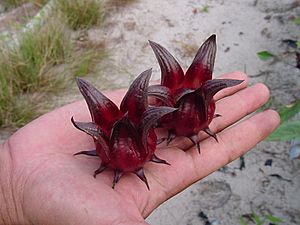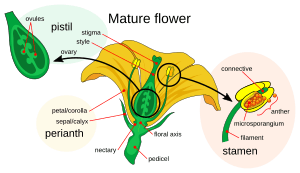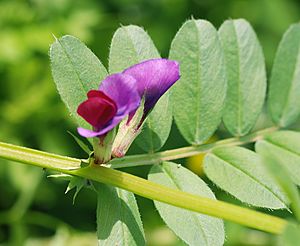Sepal facts for kids
A sepal is a special part of a flower found on flowering plants. Sepals are usually green and act like a protective shield for the flower when it's still a bud. They also help support the petals once the flower opens up. The word "sepal" was first used in 1790.
All the sepals on a flower together are called the calyx. This is the outermost ring of parts that make up a flower. Think of it as the flower's first layer of protection.
Contents
What Happens After the Flower Blooms?
After a flower blooms, most plants don't need their calyx anymore. It usually dries up or becomes very small. However, some plants keep their calyx, sometimes even making it thorny, to protect their fruit or seeds. For example, the Tomatillo and the water caltrop have a calyx that stays on.
In some plants, the calyx doesn't just stay; it actually grows bigger after the flower blooms! It can form a bladder-like cover around the fruit. This helps protect the fruit from birds and insects, like in the Cape gooseberry. In other plants, the calyx can even become part of the fruit itself, like in the Roselle plant.

Sepals Are Like Modified Leaves
From a scientific point of view, both sepals and petals are actually special kinds of leaves that have changed over time. The calyx (all the sepals) and the corolla (all the petals) are the outer, non-reproductive parts of the flower. Together, they are called the perianth.
What Are Tepals?
Sometimes, it's hard to tell the difference between sepals and petals on a flower. They might be the same color, or the flower might not have any petals at all, but the sepals are brightly colored. When this happens, we use the word tepal instead.
For example, plants like Aloe and Tulipa have tepals because their sepals and petals look very similar. But plants like Rosa and Phaseolus have clear sepals and petals that are easy to tell apart.
How Many Sepals?
The number of sepals in a flower is called its merosity. This number can actually help scientists classify plants!
- Most eudicots (a large group of flowering plants) usually have flowers with four or five sepals.
- Monocots (another group of flowering plants, like grasses and lilies) usually have flowers with three sepals, or a number that is a multiple of three (like 6 or 9).
Different Shapes of Sepals
Sepals can look very different from one plant to another.
- They can be separate from each other (called polysepalous).
- They can be fused or joined together (called gamosepalous).
- Sometimes, sepals are very small, looking like tiny scales, teeth, or ridges. These small structures often stay until the fruit is ripe and falls off.
In some flowers, the sepals are joined at the bottom, forming a calyx tube. You can see this in plants like those in the Fabaceae (pea family). In other flowers, the bases of the sepals, petals, and even the stamens (male parts of the flower) are joined together in a cup-like structure called a hypanthium.
See also
In Spanish: Sépalo para niños




